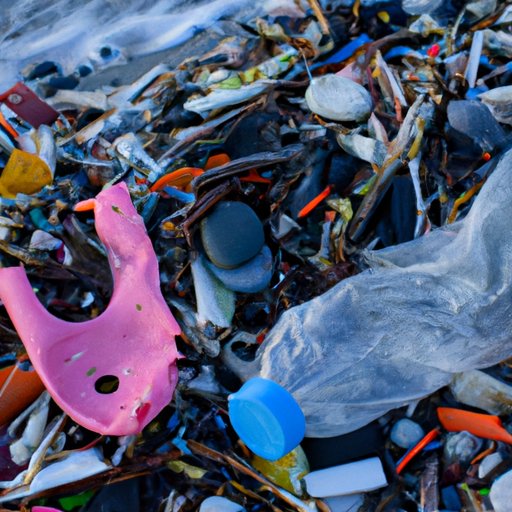Introduction
Plastic pollution is a growing global crisis that has been wreaking havoc on marine ecosystems around the world. Every year, millions of tons of plastic waste end up in our oceans, where it poses a serious threat to wildlife, habitats, and even human health. But how does plastic get into the ocean in the first place? This article will explore the sources of plastic pollution in the ocean and analyze their impacts on marine life, as well as evaluate potential solutions for reducing plastic pollution.

Examining the Sources of Plastic Pollution in the Ocean
Plastic pollution in the ocean can be attributed to a number of different sources. Human activities are one of the most significant contributors to ocean plastic pollution, as much of the plastic waste produced by people eventually makes its way into the ocean. Discarded plastics, such as plastic bags, bottles, and food containers, are some of the most common types of plastic waste that end up in the ocean. According to a 2017 report from the United Nations Environment Programme, “Up to 12.7 million tonnes of plastic enter the ocean every year, equivalent to dumping a garbage truck full of plastic every minute.”
In addition to discarded plastic waste, other sources of ocean plastic pollution include manufacturing and production processes, as well as shipping and transport. Much of the plastic used in manufacturing and production is not properly disposed of, and often ends up in rivers or the ocean. Similarly, large amounts of plastic debris are released into the ocean through shipping and transport, as many ships and boats use plastic packaging and containers to store and transport goods.

Investigating the Impact of Human Activity on Marine Life
The presence of plastic in the ocean has a devastating effect on marine life. One of the most significant impacts is the ingestion of plastic debris by animals, which can cause a variety of health issues. According to a study published in the journal Science, “Plastic ingestion by marine organisms is now ubiquitous, with more than 800 species known to ingest plastic debris.” Ingestion of plastic can lead to blockages in the digestive tract, malnutrition, and even death.
In addition to ingestion, animals can also become entangled in plastic debris, which can restrict movement and cause suffocation. Animals may also suffer from habitat destruction due to the presence of plastic debris, as plastic can smother coral reefs and disrupt the delicate balance of marine ecosystems.
Analyzing the Effects of Discarded Plastics in the Ocean
Discarded plastics in the ocean also have a range of negative environmental impacts. One of the most significant effects is the accumulation of microplastics, which are tiny particles of plastic that are less than 5 millimeters in size. According to a study published in the journal Nature Communications, “Microplastics are present in all five major ocean basins, with concentrations ranging from 0.1 to 1.9 particles per cubic meter.” Microplastics are particularly harmful to marine life, as they can easily be ingested by animals and cause a variety of health issues.
In addition to microplastics, discarded plastics in the ocean can also release a range of chemical pollutants, such as heavy metals, pesticides, and flame retardants. These pollutants can have a toxic effect on marine life, and can accumulate in the tissues of animals, leading to long-term health issues. Furthermore, discarded plastics can reduce oxygen levels in the ocean, as they block sunlight, reducing the amount of photosynthesis that occurs. This can have a detrimental effect on marine life, as many species require oxygen to survive.

Exploring the Role of Ocean Currents in Transporting Plastic
In addition to being released directly into the ocean, plastic pollution can also be transported by ocean currents. Ocean currents are driven by global circulation patterns, such as the Gulf Stream, and regional circulation patterns, such as the California Current. There are also surface and subsurface currents, which can carry plastic debris over long distances. According to a study published in Science, “Surface currents can transport debris over thousands of kilometers, while subsurface currents can transport debris over hundreds of kilometers.” This means that plastic pollution that is released in one part of the world can end up in another part of the world, impacting marine life far away from the source of the pollution.
Evaluating the Solutions to Reduce Plastic Pollution in the Ocean
Given the devastating impacts of plastic pollution on marine life, it is essential that we take action to reduce plastic pollution in the ocean. One of the most effective solutions is to reduce the amount of plastic that is produced and used. This can be done by encouraging people to reduce their use of single-use plastics, such as plastic bags and straws, and promoting the use of reusable alternatives. Another important step is to increase recycling rates, as this can help reduce the amount of plastic that ends up in landfills and eventually makes its way into the ocean. Finally, governments and businesses should work together to enhance waste management systems, such as improving waste collection and disposal services.
Conclusion
Plastic pollution is a growing global crisis that is having a devastating effect on marine life. While there are many sources of plastic pollution in the ocean, human activities are one of the most significant contributors. In addition to direct sources, plastic can also be transported by ocean currents over long distances. To reduce plastic pollution in the ocean, it is essential that we take steps to reduce plastic use, increase recycling rates, and enhance waste management systems. By working together, we can make a difference and protect our oceans from the damaging effects of plastic pollution.
(Note: Is this article not meeting your expectations? Do you have knowledge or insights to share? Unlock new opportunities and expand your reach by joining our authors team. Click Registration to join us and share your expertise with our readers.)
